Donaghmore
See also: Donaghmore in Penal Times Vincent Mulvany
Donaghmore Round Tower and Medieval Church
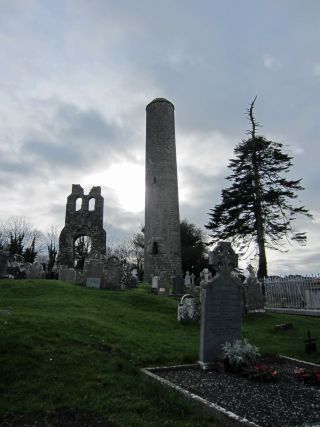 Just about 1 km or so outside Navan on the N51 road to Slane are the ruins of Donaghmore Monastic Settlement.
Just about 1 km or so outside Navan on the N51 road to Slane are the ruins of Donaghmore Monastic Settlement.
Pictured here are the strong remains of the 10th century Round Tower and the
ruins of the 16th century medieval church.
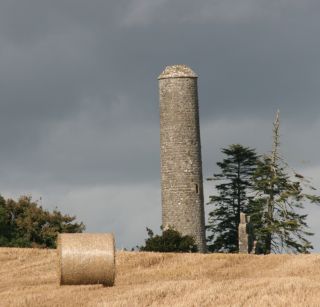
Photos: © Navan & District Historical Society
Donaghmore - This site was originally known as Domnach Mór - the Great Church. The church here was originally a patrician (St. Patrick) foundation. The church was said to have been blessed by St. Patrick, and given into the care of one of his followers St. Cassanus.
Donaghmore was well known, and mentioned in the Book of Kells. In one of the deeds of the Book of Kells it is stated that the monks at Kells bought the lands at Donaghmore for 20 ozs of gold. The deed is witnessed by Ó Dunan, Bishop of the northern half of Ireland, the King of Tara and Ó Fiachiach custodian of Donaghmore. It is dated before 1094, when we know Bishop Ó Dunan died.
Donaghmore was an important place down the ages. It was inhabited first by a celibate clergy, but gradually evolved into a community of married clergy and laymen called "mainig". This early Christian monastery would have consisted of a collection of wooden huts surrounded by a circular enclosure, with perhaps a stone church and round tower.
It survived until the tenth century. The round tower is typical of the round towers built in Ireland during the times of the Viking Invasions. It is 110 ft high and has a circumference of 66 ft at its base, and is built of undressed limestone. (see link Early Christian Navan)
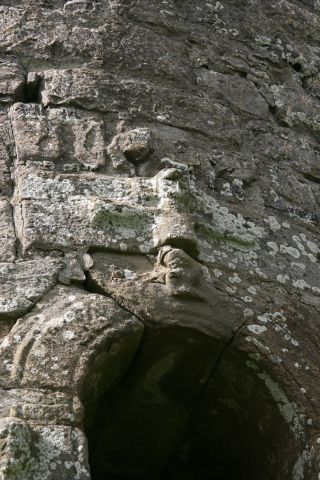
(above) The Crucifixion in relief over the door of the Round tower with a carved stone head on each side of it . Photo: © N&DHS
The Church was replaced in the 13th century by a new and larger structure, built by Anglo Norman settlers. Only the western end and belfry of this church remain.
The graveyard contains many interesting features including an early Christian Cross and headstones from the 18th century.
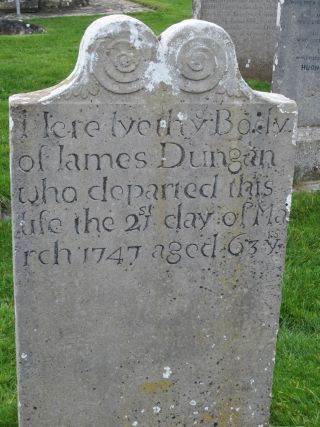
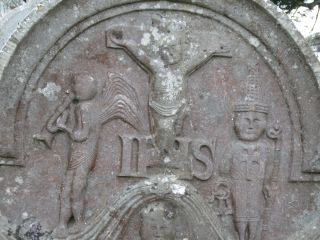
(above) Two 18th century headstones. The one on the right shows an angel and a bishop.
The graveyard contains the grave of a Croppy. Croppies was the name given to those who took part in the 1798 Rebellion against British rule. This unknown Croppy was brought here for burial in the still of the night by neighbours who found his body. It is unusul for a Croppy to be buried in sacred ground.
The graveyard also contains the vault of the Fitzherberts, a landlord family of Navan, associated with Blackcastle.
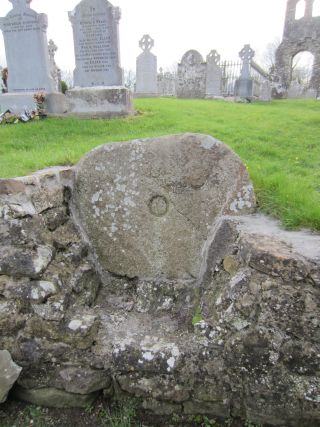 William Morgan was an important miller in
William Morgan was an important miller in
Navan in the 19th century.
He owned a large corn mill which was located at the end of
and a bakery in Watergate St.
He is buried in Donaghmore Graveyard.
One of the millstones from
Morgan's Mill has been converted into a seat and can be found along the perimeter wall of Donaghmore Graveyard.
(pictured left)
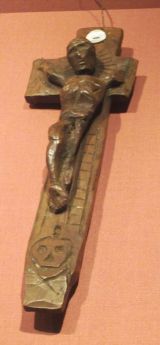 The Donaghmore Penal Cross
The Donaghmore Penal Cross
In the early 1900s, the Penal Cross illustrated here was found in the
thatch of the house of Patrick and Annie Flood, Proudstown Navan, when it was being re-thatched.
The house was very old - possibly going back 400 years and the
cross was very well hidden.
The homemade cross is made of yew wood and has the date 1535 inscribed on the back.
The right arm of the cross is broken off.
The cross was given to St. Patrick's College Maynooth by the Flood family and it is now part of a display of Penal Crosses there.
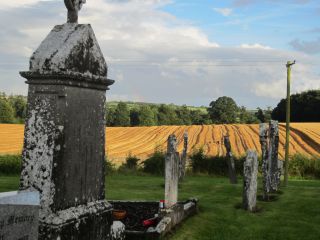
*******
Archaeological Inventory of County Meath, compiled by Michael J. Moore, (Dublin 1987)
p.134
1383 - DONAGHMORE - OS 25:7:1, (54.0, 41.2) 'Church (in ruins)' @Round Tower' OD 100-200 N 8848, 6977
Early Christian Monastry Round tower with round headed door c. em above ground level and surmounted with crucifixion scene (Barrow 1979, 162-6). W wall of medieval church with belfry attached also on site. SMR 25:15 16/10/1984
1384 - DONAGHMORE - OS 45:7:1 (53.1, 38.7) 'G.YD.' OD 200 O 0822, 5062
Church - Grass covered foundations of E-W building (dims. L 12m, W 7m). SMR 45:8 14/8/1970
~~~~~~~~~~~~~~~~~~~~~~~~~~~~~~~~~~~~~~~~~~~~~~~
Recent Excavations at Donaghmore:
http://www.excavations.ie/report/1990/Meath/0001025/
County: Meath Site name: 'Donaghmore' Blackcastle Demesne
Excavations.ie number: 1990:090 License number: —
Site type: Cist cemetery
The site was brought to the attention of the National Museum of Ireland following ploughing, in the field opposite Donaghmore Round Tower, Navan, Co. Meath. Having identified the discovery as being the capstone of a cist burial a limited excavation was carried out at the behest of the National Museum of Ireland. The site is located on light, fertile, well drained soil above the west bank of the Boyne River, 1.5km north-east of Navan town. So far five cists have been excavated and a sixth uncovered.
Cist 1
Oriented east-west, was well constructed of four large, straight edged stones and covered by a large capstone. The cist measured 1.35m by 0.75m and 0.5m in depth. It contained the remains of the fragile, decayed skeleton of a child. From its position it would appear to have been crouched. The pit into which the cist was built was only slightly larger than the cist, measuring l.45m by 1m. No grave goods were found.
Cist 2
Oriented east-west, was located only 0.4m west of Cist 1. This was a large and more roughly built cist, measuring l.3m by lm and 0.45m in depth. It was constructed of six large, irregularly shaped stones, which were not bedded very deeply into the old ground surface. The capstone was missing, probably removed during previous ploughing or land clearing and no indication of a pit was found. The cist contained the remains of one skeleton, aim adult in a crouched position. A poorly preserved pot was found near the skull.
Cist 3
Again oriented east-west, was located 4.5m west of Cist 2. A crudely built cist consisting of a large pit measuring I .6m by 1m and 0.5in in depth. Although the capstone was in situ the burial had been disturbed, most likely by an animal. The remains of the adult skeleton were disarticulated. Three grave goods were found, a Food Vessel sherd, a worked flint and a polished stone.
Cist 4
This disturbed burial was located 2m west of Cist 3 and appears to be oriented north-south. Only three side stones survived, within which a substantial cremation deposit was found, Immediately outside the area of the edging stone part of a skull was found.
Cist 5
Located 1.75m east of Cist 3, which from the surface seemed to be a Pit Burial, in that it appeared as a dark stain in the ground and had no capstone. However, when excavated it was revealed to be lined with four upright slabs, which did not reach the top of the pit. The remains of a skeleton, that of a child, was found. The bones were very fragile and very few survived.
Cist 6
This was located west of Cist 4. It was sealed by a very large capstone and the surface of a pit was visible. This cist has not been excavated.
Helen Roche, Dept. of Archaeology, University College, Dublin.
Sources:
"Early Christian Navan" Rev. Gerard Rice Meath Chronicle Feb. 1981
"Donaghmore Monastic Settlement and Graveyard" by Cepta Dungan in Navan - Its People and Its Past vol 2 (2013) Journal of the N&DHS.
The story of the Croppy Grave was recounted by Winnie McGoona to the author above. The McGoona family has kept the oral tradition of Donaghmore alive since Penal times, as the stories have been handed down through the generations and recorded faithfully.
Photos: © Navan & District Historical Society
*******
The Lewis Topographical Directory was first published in 1837 in two volumes, with an accompanying atlas. The first edition is available online. A second edition was published in 1842.
Lewis relied on the information provided by local contributors and on the earlier works published such as Coote's Statistical Survey (1801), Taylor and Skinner's Maps of the Road of Ireland (1777), Pigot's Trade Directory (1824) and other sources. He also used the various parliamentary reports and in particular the census of 1831 and the education returns of the 1820s and early 1830s. Local contributors were given the proof sheets for final comment and revision. The names of places are those in use prior to the publication of the Ordnance Survey Atlas in 1838. Distances are in Irish miles (the statute mile is 0.62 of an Irish mile).
Donaghmore, or Dunaghmore, a parish, in the barony of Lower Navan, county of Meath, and province of Leinster, 1 1/2 mile (N.) from Navan; containing 2132 inhabitants. An abbey is said to have been founded here by St. Patrick, who placed St. Justin over it: its remote antiquity is corroborated by its round tower, which rises from a projecting plinth to a height of 70 feet, being 60 feet in circumference near the base; a portion of the stone roof remains, and the doorway on the east side is six feet from the ground; it is remarkable, in having on the key stone of the entrance, a sculptured representation of Christ suffering on the cross.
The parish is situated at the junction of the rivers Blackwater and Boyne, and comprises 3824 statute acres, as applotted under the tithe act: the land is generally good and under tillage; there is neither bog nor waste. Black Castle is the handsome residence of Richard Ruxton Fitzherbert, Esq.; the mansion is a spacious and modern structure, situated on the banks of the Boyne, which flows within sight of it; the demesne is extensive and well planted. Ratholdren Castle, the seat of the late —Cusack, Esq.; and Nevinstown, of Smith White, Esq.; are also within the parish.
It is a rectory, in the diocese of Meath, and is part of the union of Navan: the tithes amount to £280 and there are about 8 1/2 acres of glebe, valued at £17 per ann. In the R. C. divisions also it is part of the union or district of Navan. At Flower Hill there is a school house built partly by Government, and partly by subscription, at an expense of £250: it is supported by annual donations from the Earl of Essex, Earl Ludlow, R. R. Fitzherbert, Esq., and the rector; about 40 boys and 30 girls are taught in it. Here are the ruins of a small church, with a high circular headed arch, supporting part of a belfry.
*******
Slater's Directory, 1894
Donaghmore, a parish in Co. Meath, barony of Lower Navan, union of Navan, diocese of Meath, containing 12 townlands and part of the market town of Navan with stations on the Midland Great Western and the Great Northern railways, between the Blackwater and the Boyne
Black Castle, the seat of Richard R. Fitzherbert esq. J.P. is in well wooded grounds close to Navan; and Rathaldron Castle, Ferdinand O'Reilly esq. J.P. is 2 miles from that town. There is a round tower here, somewhat different from the usual towers, and a ruined church. The area comprises 3,955 acres ; the population in 1891 was 723, of which 347 are in Navan.
Private Residents:
Delany, Mark J.P. Dunmoe
Fitzherbert, Richard R. J.P. Black castle.
O'Reilly, Ferdinand D.L. Rathaldron castle
Farmers:
Curran, James, Proudstown.
Fagan, John, Antyestown.
Gibney, James, Batterstown.
Halpin, John, Simonstown.
Lynch, Patrick, Blackcastle.
O'Reilly, Edward, Greggs.